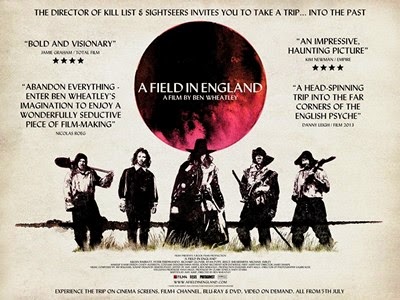Film Industry: A Field In England
Read the Media Magazine feature on A Field In England in Issue 47.
1) Write a 100 word summary of the Media Magazine article.
The article discusses the importance of the distribution method of a film when it comes to generating revenue and an audience. It is a complex process that requires a lot of work through research and creativity, even after the film has been released. This industry of distribution is dominated by Hollywood- "The top 10 distributors had a 95% share of the market in 2012", revealing the fact that it is extremely difficult for new, unknown films to be distributed and even make any profit.
A Field in England is an excellent example of a film that tried to go against the rules of distribution. The film cost £300K to make and it had a unique distribution method. It was released simultaneously (on the same day) on to multiple platforms- VOD (4OD and iTunes), free broadcast TV (Film4), DVD, BluRay and cinema (17 Picturehouse venues). This distribution method allowed A Field in England to generate a total audience of 346,000 views on TV alone and make £21,399 over its opening weekend. This method leaves us to question how distribution will change in the future and whether Hollywood movies will have to alter their profitable ways.
2) Read the following pages on the official website for A Field In England and write a one-sentence summary of each. Each page provides explanations of the unique release strategy that the institutions behind the film chose:
Industrial Evolution: Producer Andy Starke on the music industry influences informing A Field In England’s release strategy.
The simultaneous release of a film (especially a low budget Art House film) across all platforms makes more sense as these films don't get as much screen time as Hollywood blockbusters.
Screening/radical release: Commissioning Executive Anna Higgs on the groundbreaking release plans for A Field In England.
They believed that this was an extraordinary film and that it, therefore, required a different approach regarding its distribution that would reach the maximum amount of attention to attract the maximum number of target audiences.
Audience: Anna Higgs discusses where A Field In England sits within British cinema and how it will reach its intended audience for the film.
Higgs believes that the film will become a classic in the future; Ben has given the film total creative freedom that allows the audience to take a trip in to his world.
3) How was A Field In England’s release different to typical film releases?
The film was released spontaneously across all media platforms (cinema, TV, VOD, etc.) on the same day. Films are usually released in cinema first and don't come on any other platform until months after its initial release.
4) What are the advantages to releasing the film across all platforms on the same day?
It allows audiences to choose how they want to watch the film. It also allows the film to reach a wider audience and it creates an excitement around the film in the same period, meaning that the film generates essentially free advertising.
5) What are the disadvantages to this approach?
The disadvantages is that the film will lose potential revenue that it could have generated if it was released in the thypical way. People may not see the point of going and paying for a ticket to watch it in cinema when it is available on TV for free.
6) What target audience would A Field In England be aimed at? Think about demographics and Psychographics.
Demographics:
- Middle class (ABC1)
- Aged roughly 25-45 years
- British white
Psychographics:
- Reformers- people who are open to change
- Succeeders- people who have successful careers and enjoy going to art-house cinemas to watch art-house movies
7) Do you think all films in future will be released across all platforms simultaneously in future? Why? What role will technology play in film distribution?
I think it is very likely that future films will be released in a similar way to A Field in England because of the advances of new technology. Technology has allowed us to stream movies and download them even before they are removed from cinemas and released on to DVD. This means that audiences won't be willing to wait until a movie is released on DVD to watch it- they can just watch it online. This means that businesses will lose money if they continue to release movies in the same way that they are released currently.
8) Why was Chicken unable to use such a release and distribution strategy when it was made in 2014?
Chicken was unable to be released in this way because it was unable to form a distribution deal until 2015.
Extension work: read the rest of the official website's digital masterclass – there is a huge amount of information about the film from initial idea and financing to filming, editing and release.

Comments
Post a Comment